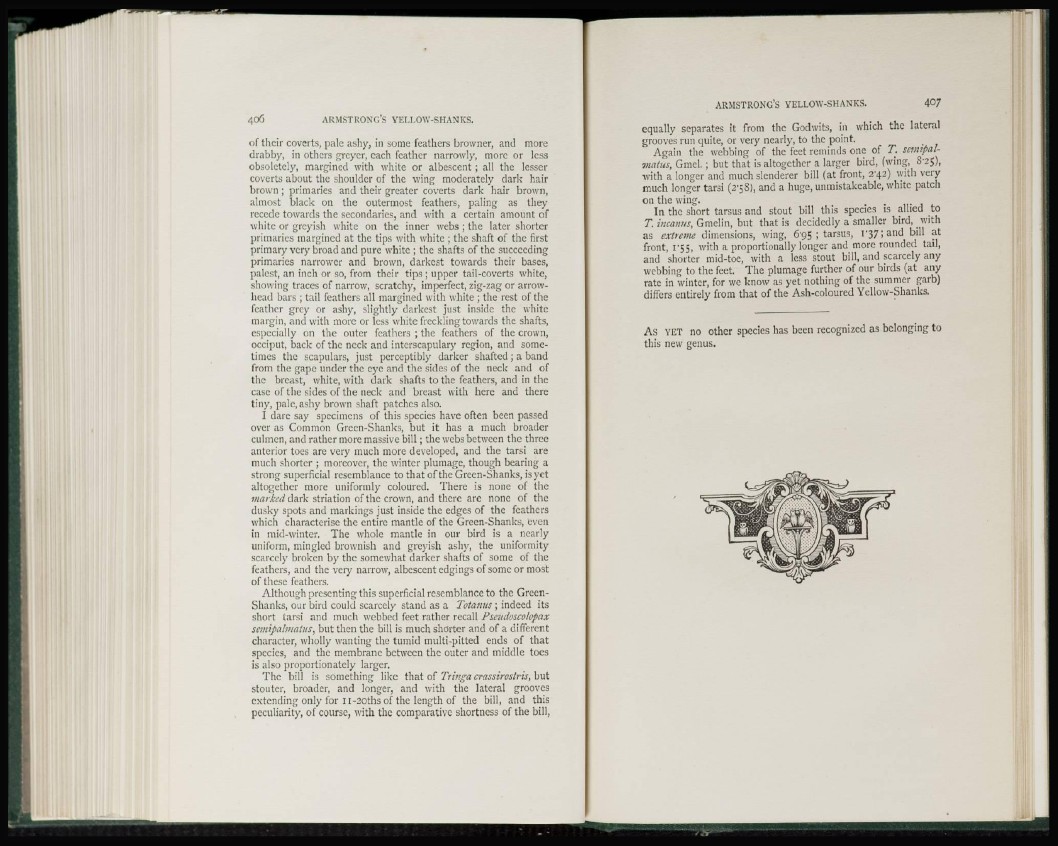
of their coverts, pale ashy, in some feathers browner, and more
drabby, in others greyer, each feather narrowly, more or less
obsolctely, margined with white or albescent ; all the lesser
coverts about the shoulder of the wing moderately dark hair
brown ; primaries and their greater coverts dark hair brown,
almost black on the outermost feathers, paling as they
recede towards the secondaries, and with a certain amount of
white or greyish white on the inner webs ; the later shorter
primaries margined at the tips with white ; the shaft of the first
primary very broad and pure white ; the shafts of the succeeding
primaries narrower and brown, darkest towards their bases,
palest, an inch or so, from their tips ; upper tail-coverts white,
showing traces of narrow, scratchy, imperfect, zig-zag or arrowhead
bars ; tail feathers all margined with white ; the rest of the
feather grey or ashy, slightly darkest just inside the white
margin, and with more or less white freckling towards the shafts,
especially on the outer feathers ; the feathers of the crown,
occiput, back of the neck and intcrscapulary region, and sometimes
the scapulars, just perceptibly darker shafted ; a band
from the gape under the eye and the sides of the neck and of
the breast, white, with dark shafts to the feathers, and in the
case of the sides of the neck and breast with here and there
tiny, pale, ashy brown shaft patches also.
I dare say specimens of this species have often been passed
over as Common Green-Shanks, but it has a much broader
eulmen, and rather more massive bill; the webs between the three
anterior toes are very much more developed, and the tarsi are
much shorter ; moreover, the winter plumage, though bearing a
strong superficial resemblance to that of the Green-Shanks, is yet
altogether more uniformly coloured. There is none of the
marked dark striation of the crown, and there are none of the
dusky spots and markings just inside the edges of the feathers
which characterise the entire mantle of the Green-Shanks, even
in mid-winter. The whole mantle in our bird is a nearly
uniform, mingled brownish and greyish ashy, the uniformity
scarcely broken by the somewhat darker shafts of some of the
feathers, and the very narrow, albescent edgings of some or most
of these feathers.
Although presenting this superficial resemblance to the Green-
Shanks, our bird could scarcely stand as a Tetanus ; indeed its
short tarsi and much webbed feet rather recall Pseudoscolopax
semipalmatuSj but then the bill is much shorter and of a different
character, wholly wanting the tumid multi-pitted ends of that
species, and the membrane between the outer and middle toes
is also proportionately larger.
The bill is something like that of Ttinga crassirostris, but
stouter, broader, and longer, and with the lateral grooves
extending only for i i-20ths of the length of the bill, and this
peculiarity, of course, with the comparative shortness of the bill,
equally separates it from the Godwits, in which the lateral
grooves run quite, or very nearly, to the point.
Again the webbing of the feet reminds one of T. scmipalmatus,
Gmel. ; but that is altogether a larger bird, (wing, 8-25),
with a longer and much slenderer bill (at front, 2'42) with very
much longer tarsi (2'58), and a huge, unmistakeable, white patch
on the wing.
In the short tarsus and stout bill this species is allied to
T. incanus, Gmelin, but that is decidedly a smaller bird, with
as extreme dimensions, wing, 695; tarsus, r37;and bill at
front, 1*55, with a proportionally longer and more rounded tail,
and shorter mid-toe, with a less stout bill, and scarcely any
webbing to the feet. The plumage further of our birds (at any
rate in winter, for we know as yet nothing of the summer garb)
differs entirely from that of the Ash-coloured Yellow-Shanks.
As YET no other species has been recognized as belonging to
this new genus.